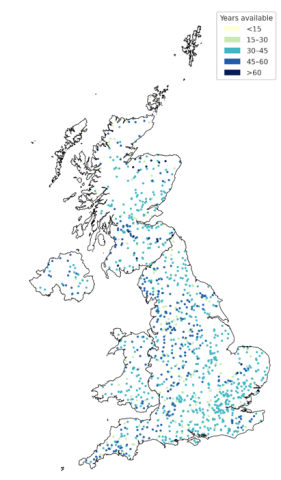What is the dataset and who is the team behind it?
UKFlow15 is a collation of sub-daily river flow observations from the different providers in the UK. It draws from data recently available at APIs as well as additional data obtained with the collaboration of the different measuring authorities in the UK. The dataset provides much needed high-resolution flow information for large-sample hydrology, including the recently released CAMELSGB v2. The community effort to deliver UK-Flow15 has come from:

What are these observations, and how did we bring them together?
The UK-Flow15 dataset brings together records from 1,369 gauging stations across England, Scotland, Wales, and Northern Ireland, representing more than 1.8 billion individual 15-minute flow observations. On average, each station provides around 40 years of continuous data, with the longest record dating back to 1948. Together, these observations capture the full diversity of the UK’s hydrological landscape, from small upland catchments to large lowland river systems, offering an unprecedented national picture of river flow variability.
Our aim was to gather all available 15-minute river flow data in the UK into a single, consistent product to support new understanding of flood dynamics and a wide range of potential applications including the development of new flood risk estimation methods and model benchmarking. This required extensive coordination with the main measuring authorities to access and collate data from different systems and formats. The resulting dataset provides a coherent record of high-resolution river flow observations across the UK.
Further details on data collection, processing, and quality assurance will be available in a soon-to-be-published research paper (UK-Flow15 Part 1).
The image below shows River flow stations and number of years of data available in UK-Flow15:

How do we make sure a national river flow dataset is accurate and reliable?
The data has undergone extensive quality control, including visual inspection of all the time series and automated statistical checks to flag potential artefacts of the data. The aim was to inform users of potential issues and provide clear indications of where the data may be unsuitable for certain types of analysis, while keeping the original records intact to preserve transparency and traceability.
How can I use UK-Flow15?
15-minute flow observations provide the high resolution data we need to analyse flood waves, especially in high response catchments during extreme weather events. UK-Flow15 will have applications in research and industry for hydrological monitoring, including as part of flood risk assessments.
What were the key learnings from collating the dataset?
Collating a national dataset is a challenging task! It involved coordinating with multiple organisations and retrieving the most complete records available. Each file had to be carefully checked and harmonised by first understanding its structure and resolving inconsistencies before producing a final, coherent dataset.
This work took over four years to complete and would not have been possible without the support and collaboration of all project partners and the dedication of the many individuals who helped to move the project forward.
Are there any future plans with the data?
UK-Flow15 has already been used to support the development of CAMELS-GB v2, providing high-resolution flow information for large-sample hydrology.
Looking ahead, we hope to advance UK river hydrology by maintaining open access to the dataset and continuing to expand it as data become available. Plans are already in place to update UK-Flow15 with additional information, including river level time series, and to continue the ongoing collation of newly released records from measuring authorities.
Are you planning to use, or already using, UK-Flow15? We want to hear from you! We’re on the lookout for case studies of how FDRI-enabled data is being used across research and industry. We’re on the lookout for case studies of how FDRI-enabled data is supporting research and industry. We’re keen to share success stories and learnings with the community, as well as ensure we prioritise the right data resources for future updates. Contact Anna Klaptocz to share your experience and get a chance to feature in our newsletter.